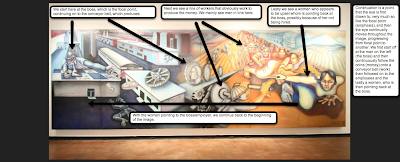Wednesday, July 11, 2012
Monday, July 9, 2012
Thursday, June 28, 2012
Monday, June 25, 2012
Monday, June 18, 2012
Positive and Negative Space
Positive and Negative Space: Positive space is the space that
is occupied by the subject, whereas negative is the space that is not your
subject.
Here is in this example of positive and negative space it
appears to be a butterfly (positive space), but if you look in the negative
space (black portion) you can identify 2 figures that are giving a “thumbs up”
to one another with there other hand right above them. Understanding the
concept of positive and negative really makes you step back and think of whether
or not you are looking at the positive or negative space, or if it is present
or if you can either correctly identify it.
Oblique Projection
Oblique Projection: A system for projecting space, in which
the front of the object or building is parallel to the picture plane, and the
sides, receding at an angle, remain parallel to each other.
Hermann Bollmann’s 1963 map of New York City is a remarkable
map. The attention to detail is superb, making this a great example of oblique
projection. Notice how the buildings are perfected with parallel lines and how
it keeps an angle. This is almost identical to axonometric in that both provide
a three-dimensional look.
Monday, June 11, 2012
Iconoclasm...
Artist, Zhang Hongtu’s iconoclasm work of “Chairmen Mao” was
developed in 1989. This was after the fact that the Chinese government rejected
the pro-democracy movement. Mao was such a pervasive leader, artist Zhang
created “Chairmen Mao,” which depicts Mao as being a child with ponytails to
portray Mao as not being a man/grown-up. It wasn’t long before that the image
of Mao soon got out and on public magazines and papers.
Monday, June 4, 2012
Aesthetically pleasing!
When I first think of aesthetically pleasing, I right away think of Bob Ross. Growing up and watching him paint on live television was very pleasing to me to watch. Like many of the paintings by Pablo Picasso (Seated Bather, Les Demoiselles d' Avignon), Bob Ross was very much like him, in my opinion, because of how they both captivate us the viewer in such an aesthetically pleasing ways.
Artists give form to the immaterial - hidden of universal truths, spiritual forces, personal feelings.
In this wonderful work of art done by Sarah Joncas titled "Leave your makeup on, and I'll leave on the light", is definitely geared towards personal feelings. Yet still one could reflect the world from this painting, it is more sought ought how women feel sometimes. This maybe unknown for sure, but Joncas could have experienced something in her lifetime to reflect such a painting. Like Kusama, whom had the hallucinations of polka dots when she was younger - this could be related along the same lines too.
Artists make functional objects and structures (buildings) more pleasible!
The above picture is of an unknown artist. The reason why I chose this picture (sidewalk art), is because right away I though of these kind of paintings that reflected how artists make use of functional objects. Here, in this example, the artists uses a functional walkway as their "artboard," and creates stunning pictures. Only viewable from certain angles will one get to fully engulf themselves into this experience. Similar to the African artist Kane Kwei, both utilize a structure and turn it into a work of art.
Artists make a visual record of the people, places, and events of their time and place!

This work is identical to that of John Ahearn's "Pat."
Artists help us to see the world in new and innovative ways!
This piece of art, better known as the famous "Fox Games" installations was created by New York artists Sandy Skoglund. Skoglund's work is identical to the works of Kusama, in which they both narrow in on a specific idea. We all know that Kusama's idea was the polka dots, and now we are shown Skoglund's idea - foxes. The wonderful use of the red foxes with the grayed out background makes the foxes jump right out at you. This is just one of many works of art by Skoglund. This work of art is a prime example of how the artist (Sandy Skoglund) promotes us to see the world in such an innovative, creative way.
Subscribe to:
Comments (Atom)







































